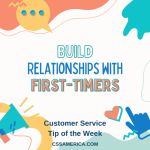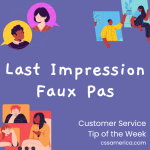
You don’t have to have the innate ability to perfectly understand the other person. You don’t have to know every answer. You don’t have to react immediately with the perfect response to what’s been said. To be great at customer service, you don’t have to be the perfect conversationalist.
Having the rapid-fire response, the quick answer, and the immediate set of perfect words is somewhat unrealistic, and definitely overrated.
A conversation is a dialogue, a sharing of ideas and thoughts and opinions and facts, back and forth. But the sharing in a customer service-related conversation has very distinct purposes. The purposes often involve establishing a rapport, understanding the other person, and addressing their need.
One thing that can positively impact rapport, understanding, and successfully addressing the need is a simple – but underused (and underrated) technique – the pause.
Too many conversations with complaining customers are made worse due to a hasty and ineffective (or inappropriate) employee response. “I’m sorry you feel that way” or “Why did you do that?” or “It’s not my fault” are clear mistakes in wording in most situations.
Reactions to requests or complaints can also cause more pain than they relieve with misdirected action. How many times has an employee transferred you to the wrong person (or without asking first, or without explaining to whom you’re being transferred and why)? How many times has the customer directed you to a website when you just wanted an answer on the phone – or worse yet – directed you to a website when you drove to their store to ask a question?
Sometimes the greatest action you can take in conversing with a customer is to pause. I’m not talking 5 minutes of dead silence, but take a few seconds to think, or ask for a minute or two to research the issue. But pause.
Give yourself time to respond instead of react. Give yourself time to think of the appropriate words to say, the best clarifying questions to ask, the best next step to suggest. Then move the conversation forward.
You don’t have to be the perfect conversationalist, but you can be better if you’re just willing to be patient with yourself – and pause.
Signup for FREE Tips! Contact Us More Resources for You Visit Our Home Page























